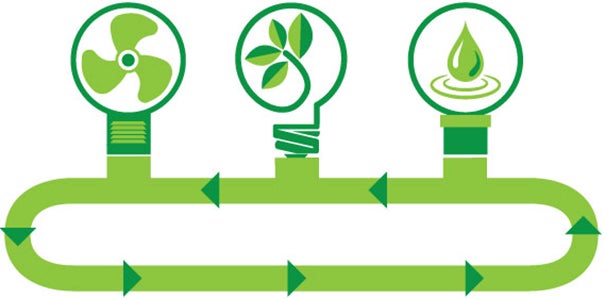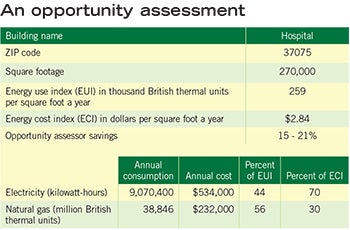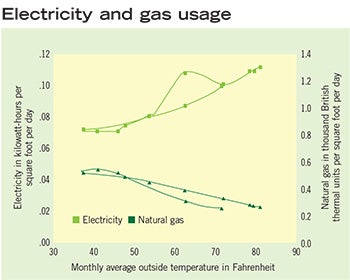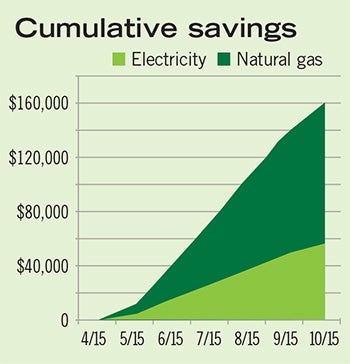Commissioning for hospital infrastructure systems

Commissioning existing and new building stock increasingly is becoming a means of identifying energy-efficiency opportunities.
There are numerous case studies and testimonials to back up the benefits of existing building commissioning. A Lawrence Berkeley National Laboratory Study titled “A Golden Opportunity for Reducing Energy Costs and Greenhouse-Gas Emissions” illustrates the financial benefits of well-executed existing building commissioning programs across all building types and market sectors.
Moreover, paybacks are quick, with health care buildings such as inpatient, outpatient and laboratory facilities achieving a return on investment in two years or less.
Many approaches
With all of these data, why is there still resistance from hospital owners and facility managers to engage in a formal existing building commissioning program? While cost is always a factor, another reason may be a lack of understanding of the various approaches available. There are many ways to address a wide range of goals and objectives from low-hanging fruit to significant changes in operational sequences to heavy capital improvement investments requiring additional design work.
You may also like |
| Resource provides commissioning support |
| Continuous regulatory compliance |
| Emergency power system commissioning |
| |
Energy audits, retrocommissioning, recommissioning, ongoing commissioning and monitoring-based commissioning all deliver varying levels of benefit when executed properly. However, these wide-swathed approaches often do not provide a seamless transition to make significant, sustainable improvements to the facility’s air quality and energy efficiency.
For example, energy audits remain on the desk without the facility’s implementing many of the well-intentioned recommendations because of lack of funding and unacceptable paybacks, a lack of clear next steps, or too many steps to take simultaneously with a small staff.
If maximizing energy efficiency and improving comfort at minimal cost is a goal of the facility director, Continuous Commissioning® may be worth considering. This is a technologically advanced approach to existing building and ongoing commissioning developed and trademarked by the Energy Systems Laboratory at Texas A&M University over the course of many years.
The process consistently achieves paybacks of fewer than three years, returns on investment greater than 30 percent and energy savings between 15 and 35 percent. Continuous commissioning is designed to improve the performance and efficiency of all types of buildings by identifying, implementing and verifying specific energy-efficient control strategies without the need for cost-prohibitive capital spending.
Reset schedules, chiller optimization and staging, effective scheduling and night setback, elimination of simultaneous heating and cooling, and proper sequencing of economizers are only a few of the common improvements applicable in almost all facilities. It has been proven that almost any facility’s operational strategy can be improved significantly with this targeted and cost-effective approach, harvesting much more energy efficiency and air quality improvements than the low-hanging fruit.
Getting started
Verifying the need for a continuous commissioning with an opportunity assessment is the first no-cost step in implementing a program. Quantifying the need early with zero investment of money and minimal investment of time can be beneficial in getting the support of executive staff and securing adequate funding.
In Brief |
|
• One way to achieve HVAC and control system efficiency in existing buildings is through continuous commissioning. • Developed by a Texas A&M lab, this program walks facilities professionals through a sequential process to achieve infrastructure cost savings. • It can significantly reduce operational costs with a relatively quick payback. |
By submitting general answers on a site questionnaire on the Texas A&M Engineering Experiment Station’s Energy Systems Laboratory website regarding the HVAC Systems in the facility (e.g., constant air volume, variable air volume, chilled water plant or district utilities) and 12 months of utility consumption data, the “opportunity assessor” software will create dozens of baseline models.
These models are then auto-calibrated by comparing measured energy use from utility bills to the energy use simulated using the local weather data and adjusting model input parameters until the two closely match.

After auto-calibration, continuous commissioning measures are then applied to the models, depending on the system configurations. A probable range of savings and an energy-use profile are then determined and documented in a short report. There is now a basis for making a financial decision to “go or no go” to the next step — a detailed assessment.
A detailed assessment
If the opportunity assessment results indicate, “Yes, energy can be reduced with a building systems tune-up,” the detailed assessment is the next step. All subsequent steps in the Texas A&M program will require a fee.
The objective of a detailed assessment is to identify where energy efficiencies and air quality improvements can be made without the need for extensive capital funding and should be conducted by professional engineers with extensive and documented experience in HVAC systems and control systems optimization utilizing the building automation system.
The detailed assessment should begin with a comprehensive study of the building. The professional should meet with existing staff and collect at least one year of monthly utility consumption data, building history, as-built drawings, commissioning plans, sequences of operation, metering information, operational problems that may exist in the building, issues faced by the central plant, occupancy schedules of the building, and present the use of each particular zone of the building including any special needs the zone may have.
However, no amount of automated trending will negate the need to physically see a valve stroke, verify calibration of a faulty sensor, witness the cleanliness of air-handling filters or functionally test the HVAC systems to the existing sequence of operation.

Control systems, boiler plant, chiller plant, air-handling units and terminal box equipment all should be exercised to determine problems and identify outdated or energy-inefficient sequences to provide sound recommendations and solutions. It is also important to conduct a “comfort baseline,” where temperature, relative humidity and carbon dioxide in each zone are investigated and recorded.
To measure and verify progress of future savings, it is imperative that an energy baseline be established using an acceptable energy model at the conclusion of the on-site investigation. The energy model should be able to estimate savings from applying targeted energy-conservation measures to the existing building and simulate the building’s current operation so it is consistent with measured consumption. Only then can the energy and financial impact of applying recommended measures be determined quickly.
This allows for the identification of measures that will have the quickest and greatest impact on reducing energy, with the highest degree of accuracy. It is important to note that not all existing building commissioning approaches include this component.
A comprehensive deliverable is the final step in the detailed assessment and serves as a valuable resource in documenting the implementation plan. The assessment report should detail how the building is using energy (i.e., energy baseline), what problems exist in the building (i.e., operationally and related to comfort) and opportunities that exist to improve efficiency and resolve problems.
These opportunities are broken into the following categories:
• Continuous commissioning-specific opportunities, such as discharge air reset, static air reset, eliminating simultaneous heating and cooling, and night setback;
• Operations and maintenance opportunities, such as repairing leaking valves, adjusting belts and cleaning filters;
• Retrofit opportunities, such as installing variable-frequency drives and upgrading controls.
All energy-savings projections identified in the energy model are generated from continuous commissioning-specific recommendations only. Any retrofit recommendations are intended for future consideration and usually will be capital-intensive and may require additional study.
The conclusion of the assessment report documents the projected savings for the building, both in consumption and dollars that would result from implementing the continuous commissioning recommendations during the implementation phase.
The cost for implementing the measures also should be identified, including the professional engineer’s fee. Only then can a financial decision be made to move forward. While there may be incidental costs for operations and maintenance opportunities, the primary cost is for the professional engineer to guide the project to a successful outcome and measure the results in accordance with the International Performance Measurement and Verification Protocol of the Efficiency Valuation Organization.
Implementation and verification
At the conclusion of the detailed assessment, a plan is provided based on real intelligence about the facility, its operation, utility consumption data and a high probability of outcome with less than a three-year payback if recommendations are executed during the implementation phase.
The implementation phase should consist of a number of site visits over the course of nine to 12 months to implement carefully and systematically all approved continuous commissioning-specific measures. This includes, for example, making sure heating measures are implemented before heating season arrives as well as ensuring that operation-and-maintenance and retrofit opportunities are implemented by building personnel. The optimization routines should then be functionally tested to verify satisfactory performance and that air quality and comfort are not sacrificed.
The conclusion of the implementation phase is training and issuing a final report. The training is designed for the energy manager and maintenance personnel to understand all changes to the building as well as information on energy conservation measures, and how to solve operational problems. The final report includes a detailed list of all measures implemented and problems resolved as well as energy and monetary savings achieved from the continuous commissioning process.
Measurement and verification should begin as soon as a reasonable number of measures have been implemented successfully. The objective is to measure accurately any savings that result from the implementation of continuous commissioning measures and to ensure that the savings are kept continuous. Beyond just knowing the performance of the project, the facility also will benefit from a monitoring component attached to the measurement and verification service. Without this level of ongoing oversight, savings ultimately will decrease over time as systems fall out of calibration and such changes as programming overrides defeat measures.
Keeping it continuous
Ultimately, space-use changes along with systems degradation will require adjustments to maintain optimal operations. The measurement and verification component means that there is a window into the facilities performance long after implementation is complete.
Even minor changes in the use of a facility may mean that operational parameters set according to previous load analysis are no longer optimal, and energy use may start to creep up. Research has shown that without the ongoing partnership and ongoing commissioning component that is integral to continuous commissioning, most, if not all, of the savings achieved will begin to disappear in a matter of years.
To make the commissioning process holistic, those who will be responsible for operating the facilities systems after measures implementation must be included in the project. Facility staff training is perhaps the most important component to maintaining a high level of performance and is a critical to the success of achieving sustainable energy savings.
Using Texas A&M Energy Systems Laboratory’s noninvasive, read-only Web-based data collection tool called “implementer” empowers the engineer to locate problems and confirm proper implementation. Upon reviewing those data, the engineer can identify inefficiencies and anomalies in building systems operations and recommend energy-saving corrections due to degradation and new energy-saving measures where applicable.
The ongoing collection of data during the continuous commissioning implementation phase enables the entire team, including the engineer and building operator, to better understand building operational trends and develop a more comprehensive range of energy-saving improvements and sustained energy savings on a continuous basis.
Ensuring efficiency
As health care organizations continue to drill down on costs, facilities infrastructures increasingly will find themselves in the crosshairs of hospital financial professionals. Developing and maintaining an effective, continuous commissioning program has proven to help these systems run as efficiently as possible in health care facilities.
Steven Harrell, CEM, CxA, is principal for SSRCx, a division of Smith Seckman Reid Inc., Nashville, Tenn. He can be contacted at sharrell@ssr-inc.com.
Commissioning approach improves performance

In 2010, a Florida health care system opened a new 350,000-square-foot inpatient care facility in the central part of the state. It was designed and built in accordance with an earlier set of design guidelines and only constant volume distribution of conditioned air was permitted in both sensitive and nonsensitive areas.
With an energy use index of 397 for the first 12 months of operation, the facilities staff quickly realized that operational improvements and energy-efficiency measures were needed.
In October 2012, a consulting-engineering firm recommended the Continuous Commissioning® approach to identify specific controls sequence modifications to the existing HVAC and building automation systems. In late 2013, the team conducted an extensive investigation of the HVAC systems to identify the operational changes that could be implemented without the need for capital investment.
Specific recommendations were identified, the most significant being converting 14 out of 25 air-handling units and corresponding constant volume terminal boxes to a variable air-volume mode.
Quantifying the projected energy savings was accomplished by creating a calibrated energy model, enabling the executive team to make a well-informed business decision. If all recommended operational changes were implemented, an estimated energy savings of 19.5 percent could be projected, yielding a 1.82-year payback and a 54.95 percent return on investment.
The final implementation plan eventually was approved in June 2014 and implementation of the 12 recommendations began in early 2015. Savings for April through October were more than $160,000, and documented results from May 2015 through December 2015 were in excess of $200,000 in savings.
If savings continue at this rate, actual payback is projected at 1.57 years and a return on investment of 63.8 percent.




